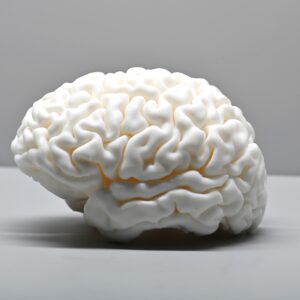The Infant Head Phantoms have been specifically developed for the validation and calibration of biophotonics imaging systems tailored to neonates. These phantoms replicate both the geometry of the neonatal head and the optical properties of infant brain tissue, offering a non-invasive platform for testing instrumentation, sensors, and wearable devices.
Two models are available:
-
Solid Homogeneous Infant Head Phantom – Anatomically shaped, based on CT scans of a 44-week neonate, with customizable optical properties.
-
Hollow Infant Head Phantom – Featuring a 2 mm thick outer shell and an internal cavity, this model is designed for filling with a suitable liquid, enabling advanced validation, suitable for different optical techniques including Diffuse Correlation Spectroscopy (DCS).
Both models support all major optical imaging modalities, including fNIRS, DOT, CW-NIRS, TD-NIRS . The hollow phantom model is particularly suited for flow-sensitive techniques (like DCS), thanks to its liquid-fillable cavity and inlet system.
These phantoms were developed in the framework of the TinyBrains European project, aimed at advancing non-invasive neuroimaging for infants, and reflect the highest standards of anatomical realism and technical accuracy.
Key Features & Benefits
✔ Infant-Specific Anatomical Accuracy – Created from clinical CT scans of a full-term neonate, capturing realistic cranial dimensions and morphology.
✔ Two Phantom Models:
-
Solid Homogeneous Head – Anatomically shaped, filled structure for standard imaging validation.
-
Hollow Head with Liquid Cavity – Allows for flow-based studies, particularly for DCS applications.
✔ Customizable Optical Properties – Both models support tailored absorption (μa) and reduced scattering (μs’) values to match experimental needs.
✔ Off-the-Shelf Option – The hollow phantom is available with:
-
μa = 0.19 cm⁻¹
-
μs’ = 7.6 cm⁻¹
✔ Suitable for All Optical Modalities – Supports fNIRS, DOT, TD/FD/CW-NIRS and DCS in anatomically relevant conditions.
✔ Safe & Ethical Testing – Enables system and cap validation without involving vulnerable infant participants, reducing ethical and regulatory burdens.
✔ Trusted Research Origin – Developed within the TinyBrains EU project, ensuring scientific rigor and clinical relevance.
Why Choose Infant Head Phantoms?
🔹 Infants require dedicated solutions—smaller size, softer tissue, and higher safety standards make standard phantoms insufficient.
🔹 These phantoms allow testing of probes, sensors, caps, and full imaging systems in a realistic yet fully safe and controlled way.
🔹 Only these phantoms combine accurate neonatal anatomy with optical and flow-based validation capability.
🔹 We developed them in collaboration with leading European research institutions through the TinyBrains project, representing the forefront of neonatal optical imaging technology.
Applications
👶 Neonatal fNIRS & DOT Device Validation – Test and optimize brain imaging systems in a realistically curved, infant-sized geometry.
💡 Diffuse Correlation Spectroscopy (DCS) – The hollow phantom supports flow simulation and perfusion testing, crucial for cerebral hemodynamics studies.
⚙️ Head Cap and Probe Design – Evaluate attachment, stability, ergonomics, and signal response without testing on real infants.
🏥 Clinical Research and Pre-Deployment Studies – Validate instrument response and imaging algorithms prior to clinical application.
📊 Optical Sensor Benchmarking – Assess the sensitivity, repeatability, and robustness of pediatric optical sensors.
The Infant Head Phantoms offer an unparalleled combination of anatomical realism and optical fidelity, tailored for the delicate and ethically sensitive world of neonatal brain imaging. With options for both standard and flow-based validation, these models are the ideal tool for advancing pediatric biophotonics.
Check the features of the two options in the following comparison table:
| Feature | Solid Homogeneous Infant Head | Hollow Infant Head with Liquid Cavity |
|---|---|---|
| Geometry | Based on CT scan of 44-week neonate | Same anatomical shape as solid model |
| Structure | Solid, homogeneous | 2 mm shell with liquid-fillable internal volume |
| Internal Volume | None | Yes – fillable cavity with inlet pipe |
| Flow Simulation (DCS Compatible) | ❌ Not supported | ✅ Yes – supports DCS and flow-based experiments |
| Optical Property Customization | ✅ Yes | ✅ Yes |
| Off-the-Shelf Availability | Varies with time, contact us for info | ✅ Yes – μa = 0.19 cm⁻¹, μs’ = 7.6 cm⁻¹ |
| Modality Compatibility | fNIRS, DOT | fNIRS, DOT, DCS |
| Use Cases | Probe and cap validation, general optical system testing | Like solid head plus perfusion/flow studies |
| Best For | Standard anatomical validation of fNIRS/DOT systems | Advanced optical studies including hemodynamic and DCS validation |
Download a printable PDF with the comparison table!
📩 Need a custom model or ready to order? Contact us to find the right solution for your research or product development.
Looking for Adult head phantoms? Check here!



